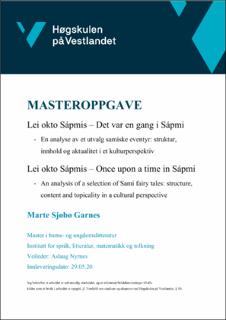| dc.contributor.author | Garnes, Marte Sjøbø | |
| dc.date.accessioned | 2020-07-01T08:06:00Z | |
| dc.date.available | 2020-07-01T08:06:00Z | |
| dc.date.issued | 2020 | |
| dc.identifier.uri | https://hdl.handle.net/11250/2660224 | |
| dc.description | Master i barne- og ungdomslitteratur
Institutt for språk, litteratur, matematikk og tolkning
Innleveringsdato: 29.05.20 | en_US |
| dc.description.abstract | This thesis studies how a varied selection of Sami fairy tales can help to actualize Sami culture in teaching. The material consists of four fairy tales from the collection Samiske beretninger by Brita Pollan (1997). The fairy tales were originally written down by Just Knud Qvigstad in the early 1900s. The purpose of the study is to assess the Sami fairy tales’ potential to satisfy the new Norwegian national curriculum content that is particularly related to the Sami.
The study is a textual analysis of the fairy tales in light of theory related to culture and text.Methodologically, the study uses both fairy tale analysis and literary analysis. The fairy tale analysis examines genre-specific aspects of the fairy tales and concentrates on the structure of the fairy tale based on Vladímir Propp's functional analysis and Algirdas Julien Greimas's
actantial model. The literary analysis examines general literary aspects of the fairy tales, with special emphasis on the landscape, characters and themes in the texts.
The findings show that the structure of the selected Sami fairy tales bears several similarities to typical Norwegian fairy tales. These fundamental similarities appear in a project with opponents and helpers. Findings from the analysis of the content show that the selected Sami fairy tales present several cultural expressions and values that can be linked to Sami culture. These are made visible through the landscape which has a crucial and important role in all the fairy tales, and the characters who represent Sami culture through their way of life, nature and world view. In addition, findings from the analysis of the theme show that love and tradition
are highlighted in all the fairy tales in the selection. This makes the fairy tales both general and specific in relation to Sami culture.
The cultural expressions and values are particularly related to traditional Sami culture, but open up a comparison with Sami culture today. This makes the fairy tales interesting both to discuss tensions in the Sami culture and tensions between Norwegian and Sami culture. The teacher's insight into and understanding of Sami culture is crucial for these tensions to behighlighted in the cultural meeting between the pupil and Sami culture. | en_US |
| dc.language.iso | nob | en_US |
| dc.publisher | Høgskulen på Vestlandet | en_US |
| dc.rights | Navngivelse 4.0 Internasjonal | * |
| dc.rights.uri | http://creativecommons.org/licenses/by/4.0/deed.no | * |
| dc.title | Lei okto Sápmis – Det var en gang i Sápmi - En analyse av et utvalg samiske eventyr: struktur, innhold og aktualitet i et kulturperspektiv | en_US |
| dc.title.alternative | Lei okto Sápmis – Once upon a time in Sápmi - An analysis of a selection of Sami fairy tales: structure, content and topicality in a cultural perspective | en_US |
| dc.type | Master thesis | en_US |
| dc.source.pagenumber | 99 | en_US |
| dc.description.localcode | MBUL550 | en_US |

